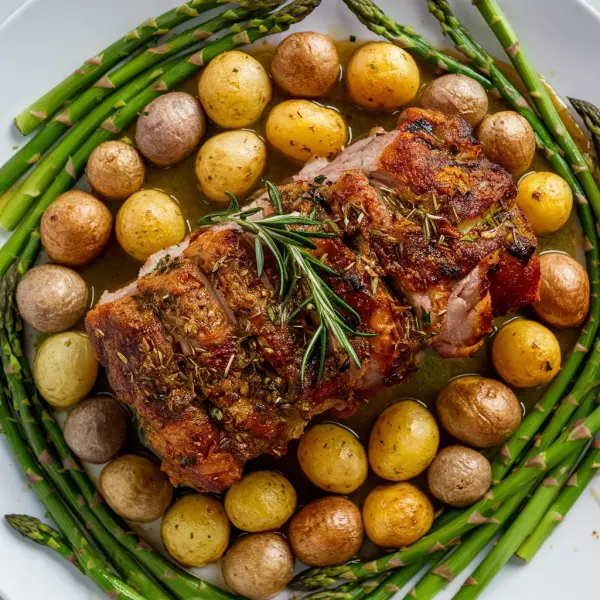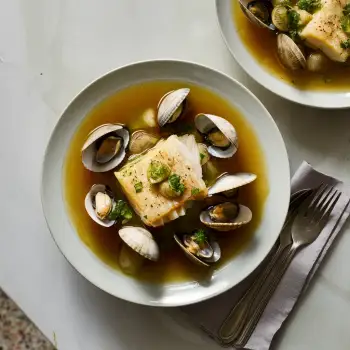
 150 minutes
150 minutesA delicious pork loin rib roast crusted with herbs and served with a rich pan sauce.


Bone-in 4-rib Pork Loin
0 lb
to taste
to taste
Fresh Sage, chopped
0 oz
Fresh Fennel, chopped
0 oz
Fresh Rosemary, chopped
0 oz
Garlic, sliced
cloves
Lemon Slices, sliced
0 oz
Wine
cups
Chicken Or Vegetable Broth
cups
1. Seasoning the Pork Loin
Start by seasoning your pork loin generously with salt and fresh-ground black pepper. If you can, do this the day before you plan to cook. This pre-seasoning step lets the flavors deeply penetrate the meat, ensuring a well-seasoned roast. When the pork loin is evenly coated with seasoning, place it in the refrigerator until you're ready to cook.
2. Preparing the Roast
Take the seasoned roast out of the fridge about an hour before cooking to let it come to room temperature. This step is important because it helps the meat cook more evenly. Tie the roast with cotton string to hold its shape during cooking. A snugly tied roast ensures even cooking and an attractive presentation.
3. Preheating and Roasting
Preheat your oven to 375°F. Place the tied roast in a roasting pan and put it in the oven. Roast for about 1 hour and 15 minutes, or until the internal temperature reaches 130°F. This temperature setting and cooking time will give you a juicy interior and a beautifully crusty exterior. If you're using herbs and lemon, rub the roast with a mixture of sage, fennel, and rosemary, and place garlic and lemon slices on top before roasting.
4. Resting the Roast
Once the roast reaches the desired internal temperature, take it out of the oven and let it rest for about 20 minutes. Resting is crucial because it allows the juices to redistribute throughout the meat, making every bite tender and flavorful. You'll know it's ready when you see juices pooling on the surface.
5. Deglazing the Pan
While the roast is resting, pour off any excess fat from the roasting pan. Place the pan over medium heat and deglaze it with some wine or broth, scraping up the flavorful brown bits from the bottom of the pan. This step captures all those delicious flavors and creates a rich sauce to accompany your roast.
6. Serving
After the roast has rested, cut the strings and slice the meat. Arrange the slices on a serving platter and pour the pan juices over the top. The herb-crusted exterior, especially with the addition of lemon slices, adds a delightful complexity to the flavor.
Swap the pork loin for a beef rib roast. Use heartier herbs like rosemary and thyme, as beef can stand up to stronger flavors.
Substitute with a rack of lamb for an elegant alternative. A crust with mint, parsley, and coriander alongside garlic and Dijon mustard complements lamb beautifully.
Mix in cumin, coriander, cinnamon, and mint for a Moroccan spin. This works great with lamb or chicken.
Incorporate oregano, basil, and thyme with sun-dried tomatoes and olives for a Mediterranean twist on any of the above proteins.
Poultry also works well with an herb crust. Swap to a whole chicken or turkey, adjusting the cooking time accordingly. Sage, thyme, and rosemary are classic poultry herbs.
Check the internal temperature to avoid overcooking, aiming for 145°F (63°C), with a rest period to follow.
Let the pork roast rest tented under foil after cooking to allow juices to redistribute for a tender result.
Begin with a high-quality, well-marbled pork loin rib roast, preferably from a heritage breed.
Sear the pork loin in a hot skillet for a flavorful crust and to lock in flavors before roasting.
Use fresh, finely chopped herbs such as rosemary, thyme, and parsley for a vibrant and adherent crust.




Comments (0)